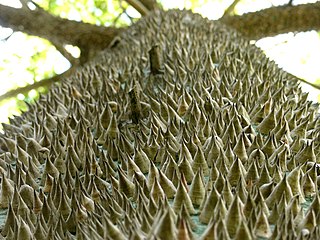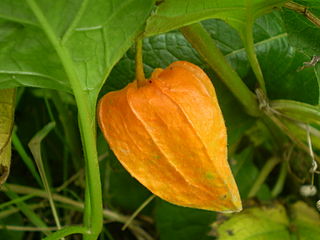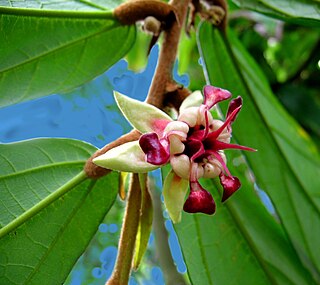
Convolvulaceae, known commonly as the bindweed or morning glory family, is a family of about 60 genera and more than 1,650 species of mostly herbaceous vines, but also trees, shrubs and herbs, and also including the sweet potato and a few other food tubers.

The Aristolochiaceae are a family, the birthwort family, of flowering plants with seven genera and about 400 known species belonging to the order Piperales. The type genus is Aristolochia L.

Zygophyllaceae is a family of flowering plants that contains the bean-caper and caltrop. The family includes around 285 species in 22 genera.

Lobelia is a genus of flowering plants comprising 415 species, with a subcosmopolitan distribution primarily in tropical to warm temperate regions of the world, a few species extending into cooler temperate regions. They are known generally as lobelias.

The family Campanulaceae, of the order Asterales, contains nearly 2400 species in 84 genera of herbaceous plants, shrubs, and rarely small trees, often with milky sap. Among them are several familiar garden plants belonging to the genera Campanula (bellflower), Lobelia, and Platycodon (balloonflower). Campanula rapunculus and Codonopsis lanceolata are eaten as vegetables. Lobelia inflata, L. siphilitica and L. tupa and others have been used as medicinal plants. Campanula rapunculoides may be a troublesome weed, particularly in gardens, while Legousia spp. may occur in arable fields.

Adelieae is a tribe of the subfamily Acalyphoideae, under the family Euphorbiaceae. It comprises 5 genera.

Bombacoideae is a subfamily of the mallow family, Malvaceae. It contains herbaceous and woody plants. Their leaves are alternate, commonly palmately lobed, with small and caducous stipules. The flowers are hermaphroditic and actinomorphic; the calyx has 5 sepals united at the base, which are not accompanied by an epicalyx (involucel). The corolla has 5 free petals and an androecium of numerous stamens, typically with free filaments which are not fused in a staminal tube (column). The pollen is smooth and the ovary superior and pluricarpellate. The fruits are schizocarpous or capsular.

Goodeniaceae is a family of flowering plants in the order Asterales. It contains about 404 species in twelve genera. The family is distributed mostly in Australia, except for the genus Scaevola, which is pantropical. Its species are found across most of Australia, being especially common in arid and semi-arid climates.

Apocynoideae is a subfamily of the flowering plant family Apocynaceae. It contains about 78 genera with roughly 860 species. Several genera are of pharmacological interest - notably those - such as Strophanthus - which have furnished highly effective arrow poisons, due to their cardiac glycoside content. The subfamily includes many species with flowers of considerable ornamental value, the best-known of which is Nerium oleander, the familiar Oleander. It also contains the remarkable pachycaul genera Adenium and Pachypodium.

Cordioideae is a subfamily of the flowering plant family Boraginaceae.

Ehretioideae is a subfamily of the flowering plant family Boraginaceae.

Chrysophylloideae is a subfamily of flowering plants in the chicle family, Sapotaceae.

The Sapotoideae are a subfamily of the flowering plant family Sapotaceae. Plants in the subfamily are characterized by their leather-like leaves, often growing in a stipule fashion.

Hippocastanoideae is a subfamily of flowering plants in the soapberry family Sapindaceae. The group was formerly treated as the separate families Aceraceae and Hippocastanaceae. Molecular phylogenetic research by Harrington et al. (2005) has shown that while both the Aceraceae and Hippocastanaceae are monophyletic in themselves, their removal from the Sapindaceae sensu lato would leave Sapindaceae sensu stricto as a paraphyletic group, particularly with reference to the genus Xanthoceras.

Larreoideae is a subfamily of the flowering plant family Zygophyllaceae.

Tribuloideae is a subfamily of the flowering plant family Zygophyllaceae.

Malveae is a tribe of flowering plants in the mallow family Malvaceae, subfamily Malvoideae. The tribe circumscribes approximately 70 genera and 1040 species and has the greatest species diversity out the three tribes that make up Malvoideae. The flowers of Malveae are five-merous with a characteristic staminal column, a trait found throughout Malvoideae. Although there are not many economically important species within Malveae, the tribe includes Althaea officinalis, otherwise known as the marsh-mallow.

Daturae is a tribe of flowering plants in the subfamily Solanoideae of the family Solanaceae. It comprises three genera: Datura, the Devil's trumpets, Brugmansia, the Angel's trumpets, and the monotypic Trompettia.

Physaleae is a tribe of flowering plants in the subfamily Solanoideae of the family Solanaceae.

Byttnerioideae is a subfamily of the flowering plant family Malvaceae.




















